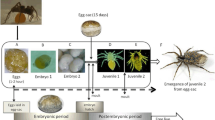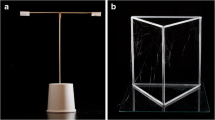Abstract
This study presents the first characterisation of the silk lipids of the cocoons of a wolf spider (Pardosa saltans). Wolf spiders’ maternal behaviour is complex and involves guarding a cocoon for several weeks, and so cocoons must emit cues to ensure their care and the development of juveniles. We investigated cues associated with the cocoon silk. We assessed qualitative changes of the lipid contents and the composition of cocoon silk in relation to the development of P. saltans wolf spider juveniles. Gas chromatography–mass spectrometry of P. saltans’ cocoon silk revealed 62 different lipid compounds. The compounds were aliphatic alcohols, glycerides, fatty acids and their methylesters containing 13–29 carbon atoms. We reveal for the first time the presence of ethanolamides and phytosterol on cocoon silk. Qualitative and quantitative changes occur during the embryonic period, as some polar compounds, such as diglycerides and ethanolamides, disappeared while hydrocarbons emerge, and fatty acids disappeared later during the post-embryonic period. Qualitative and/or quantitative changes could play a role in tactochemical communication between mothers and their cocoon. However, mothers do not modify their behaviour in relation to the developmental stage of their cocoon. Mothers’ behaviour appears to be linked to both internal (physiological state) and external mechanisms (signals from the cocoon).



Similar content being viewed by others
References
Benvenuti F, Lattanzi F, De Gori A, Tarli P (1968) Activity of some derivatives of palmytoyethanolamide on carragenine induced edema in the rat paw. Boll Soc Ital Biol Sper 44(9):809–813
Bouic PJ, Clark A, Lamprecht J, Freestone M, Pool EJ, Leibenberg RW, Kotze D, van Jaarsveld PP (1999) The effects of β sitesterol (BSS) and β sitosterol glycoside (BSSG) mixture on selected immune parameters of marathon runners: inhibition of post marathon immune suppression and inflammation. Inter J Sports Med 20(4):258–262
Canard A (1987) Analyse nouvelle du développement postembryonnaire des araignées. Rev Arachnol 7(3):91–128
Colancecco M, Rypstra AL, Persons MH (2007) Predation and foraging costs of carrying eggsacs of different mass in the wolf spider Pardosa milvina. Behaviour 144(9):1003–1018
Culley T, Wiley JE, Persons MH (2010) Proximate cues governing egg sac discrimination and recognition in the wolf spider Pardosa milvina (Araneae: Lycosidae). J Arachnol 38:387–390
Eason RR (1964) Maternal care as exhibited by wolf spiders (lycosids). Proc Arkansas Acad Sci Proc 18:13–19
Evans TA, Main BY (1993) Attraction between social crab spiders: Silk pheromones in Diaea socialis. Behav Ecol 4:99–105
Foelix RF (2011) Biology of spiders, 3rd edn. Oxford University Press and Georg Thieme, New York
Fujii Y (1977) Examinations of the maternal care of cocoon in Pardosa astrigera L. Koch (Araneae, Lycosidae). J Therm Biol 10:171–175
Fujii Y (1980) Analytical study of maternal behavior in Pardosa astrigera L. Koch (Araneae, Lycosidae). Bull Nippon Dent Univ Gen Ed 9:235–245
Kahlich R, Klima J, Cihla F, Frankova V, Masek K, Rosicky M, Matousek F, Bruthans J (1979) Studies on prophylactic efficacy of N-2-hydroxyethyl palmitamide (Impulsin) in acute respiratory infections: serologically controlled field trials. J Hyg Epidemiol Microbiol Immunol 23:11–24
Krafft B (1981) The significance and complexity of communication in spiders. In: Witt PN, Rovner JS (eds) Spider communication: mechanisms and ecological significance. Princeton University Press, New Jersey, pp 15–66
Kronestedt T (1986) A presumptive pheromone-emitting structure in Wolf spiders (Araneae, Lycosidae). Psyche 93:127–131
Kürpick SM (2000) Cocoon car in the subsocial spider Stegodyphus dumicola (Eresidae). In: Toft S, Scharff N (eds). European Arachnology 2000: Proceedings of the 19th European Colloquium of Arachnology, pp 39–44
Lubin YD (1974) Adaptative advantages and the evolution of colony formation in Cyrtophora (Araneae, Araneidae). Zool J Linnaean Soc 54:321–339
Machado G, Raimundo RLG (2001) Parental investment and the evolution of subsocial behaviour in harvestmen (Arachnida: Opiliones). Ethol Ecol Evol 13:133–150
Melchers M (1963) Zur biologie und zum verhalten von Cupiennius salei (Keyserling), einer amerikanischen Ctenide. Zool Jahrb Abt Syst Okol Geogr Tiere 91:1–10
Nørgaard E (1956) Environment and behaviour of Theridion saxatile. Oikos 7:159–192
Papke MD, Schulz S, Tichy H, Gingl E, Ehn R (2000) Identification of a new sex pheromone from the silk dragline of the tropical wandering spider Cupiennius salei. Angew Chem Int Ed 39:4339–4341
Papke MD, Reichert SE, Schulz S (2001) An airborne female pheromone associated with male attraction and courtship in a desert spider. Anim Behav 61:877–886
Pegel KH (1997) The importance of sitosterol and sitsterolin in human and animal nutrition. S Afr J Sci 93:263–268
Penman DR, Cone WW (1974) Role of web, tactile stimuli, and female sex pheromone in attraction of male twospotted spider mites to quiescent female Deutonymphs. Ann Entomol Soc Am 67:179–182
Perlík F, Raskova H, Elis J (1971) Anti-inflammatory properties of N(2-hydroxyethyl) palmitamide. Acta Physiol Acad Sci Hung 39:395–400
Pourié G, Ibarra F, Francke W, Trabalon M (2005) Fatty acids mediate aggressive behavior in the spider Tegenaria atrica. Chemecology 15:161–166
Prouvost O, Trabalon M, Papke M, Schulz S (1999) Contact sex signals on web and cuticle of Tegenaria atrica (Araneae, Agelenidae). Arch Insect Biochem Physiol 40:194–202
Roessingh P (1990) Chemical marker from silk of Yponomeuta cagnagellus. J Chem Ecol 16:2203–2216
Ruhland F (2016) Etude comportementale des interactions entre une mère lycose errante, Pardosa saltans (Araneae), et son cocon. Thesis of Rennes 1 University, France, p 197
Ruhland F, Chiara V, Trabalon M (2016a) Age and egg-sac loss determine maternal behaviour and locomotor activity of wolf spiders (Araneae, Lycosidae). Behav Process 132:57–65
Ruhland F, Pétillon J, Trabalon M (2016b) Physiological costs during the first maternal care in the wolf spider Pardosa saltans (Araneae, Lycosidae). J Insect Physiol 95:42–50
Schildknecht H, Kunzelmann P, Krauss D (1972) Über die Chemie der Spinnwebe, I. Naturwissenschaften 59:98–99
Schulz S (1997) The chemistry of spider toxins and spider silk. Angew Chem Int Ed 36:314–326
Schulz S (2004) Semiochemical of spiders. In: Cardé RT, Miller JG (eds) Advances in insect chemical ecology. Cambridge University Press, New York, pp 110–150
Schulz S, Toft S (1993a) Identification of a sex pheromone from a spider. Science 260:1635–1637
Schulz S, Toft S (1993b) Branched long chain alkyl methyl ethers: a new class of lipids from spider silk. Tetrahedron 49:6805–6820
Smiseth PT, Kölliker M, Royle NJ (2012) What is parental care? In: Royle NJ, Smiseth PT, Kölliker M (eds) The evolution of parental care. Oxford University Press, United Kingdom, pp 1–17
Trabalon M, Assi-Bessekon D (2008) Effects of web chemical signatures on intraspecific recognition in a subsocial spider, Coelotes terrestris (Araneae). Anim Behav 76:1571–1578
Trabalon M, Bagnères AG (2010) Contact recognition pheromones in spiders and scorpions. In: Blomquist GJ, Bagnères AG (eds) Insect hydrocarbons. Cambridge University Press, Cambridge, pp 344–374
Trabalon M, Bagnères AG, Hartmann N, Vallet AM (1996) Changes in cuticular compounds composition during the gregarious period and after dispersal of the young in Tegenaria atrica (Araneae, Agelenidae). Insect Biochem Molec Biol 26(1):77–84
Trabalon M, Bagnères AG, Roland Ch (1997) Contact sex signals in two sympatric spider species, Tegenaria domestica and Tegenaria pagana. J Chem Ecol 23(3):747–758
Trabalon M, Niogret J, Legrand-Frossi C (2005) Effect of 20-hydroxyecdysone on cannibalism, sexual behavior, and contact sex pheromone in the solitary female spider, Tegenaria atrica. Gen Comp Endocr 144:60–66
Vannini M, Contini Bonacossi B, Ugolini A (1986) Cocoon care in Pardosa hortensis (Araneae, Lycosidae). Biol Behav 11:85–96
Viera C, Ghione S, Costa FG (2007) Mechanisms underlying egg-sac opening in the subsocial spider Anelosimus cf. studiosus (Araneae Theridiidae). Ethol Ecol Evol 19:61–67
Wagner JD (1995) Egg sac inhibits filial cannibalism in the wolf spider, Schizocosa ocreata. Anim Behav 50:555–557
Wong NC (2001) The beneficial effect of plant sterol on serum cholesterol. Can J Cardiol 17(6):715–721
Zeh DW, Smith RL (1985) Paternal investment by terrestrial arthropods. Am Zool 25:785–805
Acknowledgements
The authors would like to thank Dr. Ann Cloarec for reading the manuscript, and Lisa Ziesche, Jana Caspers, Christopher Grimm and Marylène Chollet-Krugler for compound identification and quantification help.
Author information
Authors and Affiliations
Corresponding author
Ethics declarations
Conflict of interest
The authors declare that they have no conflict of interest.
Rights and permissions
About this article
Cite this article
Ruhland, F., Schulz, S. & Trabalon, M. Variations of cocoon external lipids during wolf spiderlings’ development. J Comp Physiol A 203, 819–829 (2017). https://doi.org/10.1007/s00359-017-1194-4
Received:
Revised:
Accepted:
Published:
Issue Date:
DOI: https://doi.org/10.1007/s00359-017-1194-4




